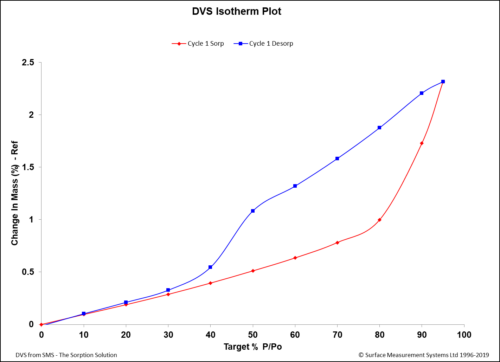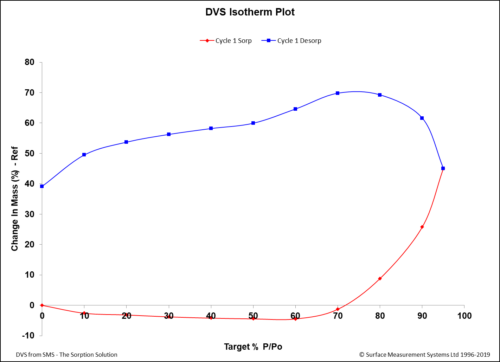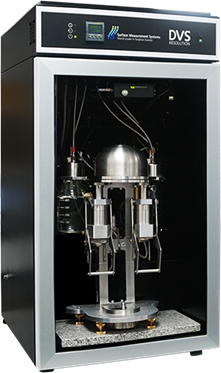Dynamic Vapor Sorption (DVS) is a gravimetric technique used to measure the change in mass of a material in response to changes to surrounding conditions such as temperature or humidity. DVS is primarily used with water vapor but can be applied to other organic solvents as well for the physicochemical characterization of solids.
DVS was developed by Daryl Williams, the founder of Surface Measurement Systems Ltd., in 1991. The company then delivered the first working DVS instrument to Pfizer in 1992.1 Since then, many other equipment manufacturers have entered the field.

Figure 1: A DVS isotherm plot indicating sorption and desorption rates and hysteresis. The isotherm shows a typical hysteresis curve where the adsorption phase is almost identical to the desorption phase (i.e. reversible). Note that at 80 %RH, there is net sorption of 0.9% between adsorption and desorption traces. The material appears to be slightly hygroscopic according to the definition in Ph. Eur.2
Sorption, Desorption, Absorption, and Adsorption
There are five main physical processes that occur during the DVS experiment. The first, sorption, is when a material takes on moisture due to increased humidity. Conversely, desorption is the process that occurs when the material loses moisture due to decreasing humidity. Sorption can be classified as one of two types. Adsorption is moisture that is observed on a surface of a material, while absorption is moisture that has penetrated the surface of a material. The fifth term and the term that relates sorption and desorption is called hysteresis. The overall chart that includes and tracks the sorption and desorption rates and hysteresis is called the isotherm. These curves are crucial for understanding the physicochemical characteristics of a solid, such as porosity, polymorphic change, or liquefying of a sample.2
Applications
There are numerous reasons to utilize DVS, and some of the most common within the active pharmaceutical ingredient (API) industry are:
- To determine the sorption isotherm;
- To evaluate the hygroscopicity of an API powder;
- To compare the hygroscopicity of different solid-state forms: solvates, polymorphs, salts, amorphicity, and cocrystals;
- To determine the deliquescence point of a material;
- To quantify and qualify the amorphous content in drug substance or excipient,3 and
- To evaluate packaging materials.
Of course, there are a variety of other applications in other industries, including for building materials, food science, cosmetics, coatings, and sealants.
DVS Analysis of APIs
For pharmaceutical development, DVS is used for a variety of applications, including screening early drug and excipient candidates, establishing processing parameters, and identifying packaging and storage requirements (Figure 2).4,5

Figure 2: A DVS isotherm of an API showing that the material started to gain significant mass after exposure to relative humidity values of more than 60 %RH. The change here was irreversible, as demonstrated by the desorption curve. DVS could be a useful tool to suggest storage conditions in terms of humidity contents in the surrounding environment.
However, due “to the typically slow establishment of an equilibrium, DVS experiments are rather time-consuming.”4 Nevertheless, “water content of solid active pharmaceutical ingredients and excipients, individually and when formulated in pharmaceutical dosage forms, is a parameter that should be monitored throughout the drug lifecycle.”5
As an analytical technique for APIs, DVS has become a necessary step within drug development and production, reducing issues that can arise during manufacturing, packaging, transportation, solubility, dissolution rate, stability, or storage. AMPAC Analytical’s sister company, SK biotek Ireland Analytical Services, has the experience, technology (including a Surface Measurement System’s DVS Resolution Dual Vapor Gravimetric Sorption Analyser), and support, to assist with this vital testing. Both companies are part of SK pharmteco and can easily transfer your project from either business unit to ensure the most optimal solution and logistical support are provided to meet your product timeline. We invite you to contact our team members and discuss how we can assist with your sorption testing requirements.

Figure 3: A SMS DVS instrument like the one located at SK biotek Ireland.
References
- Ph. Eur., 2023, 11.2 Edition, Chapter 2.9.39

